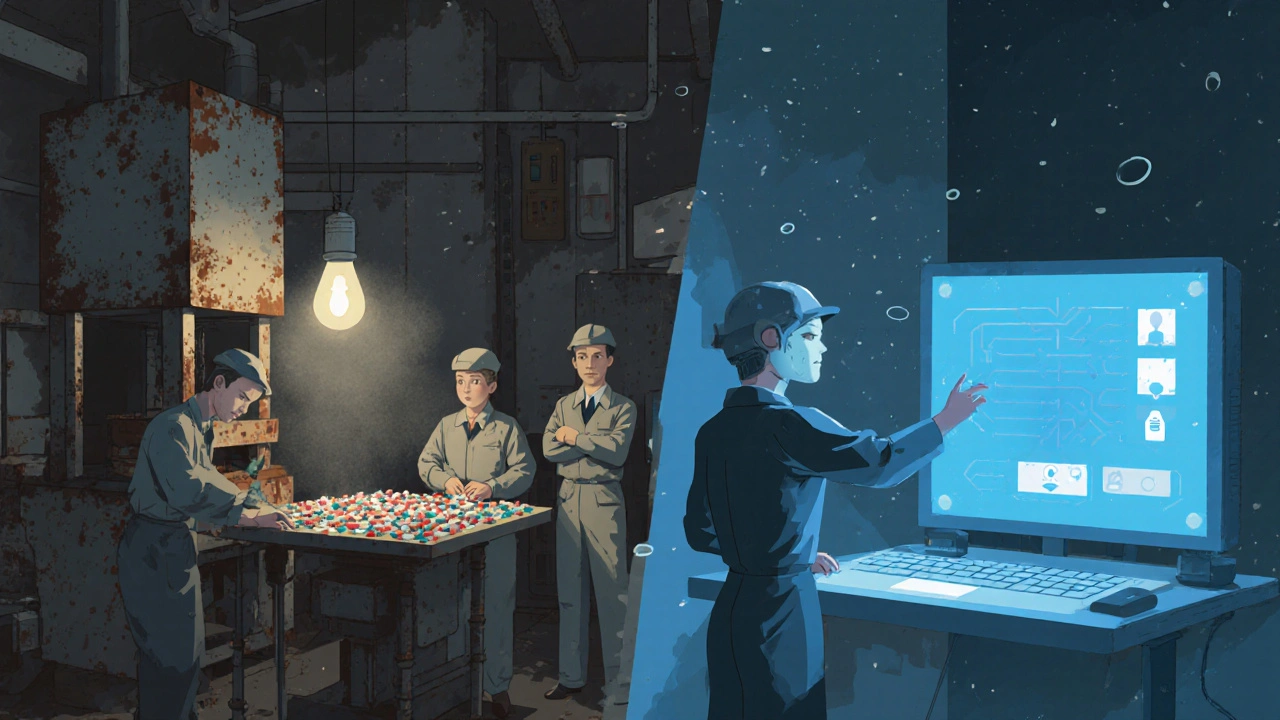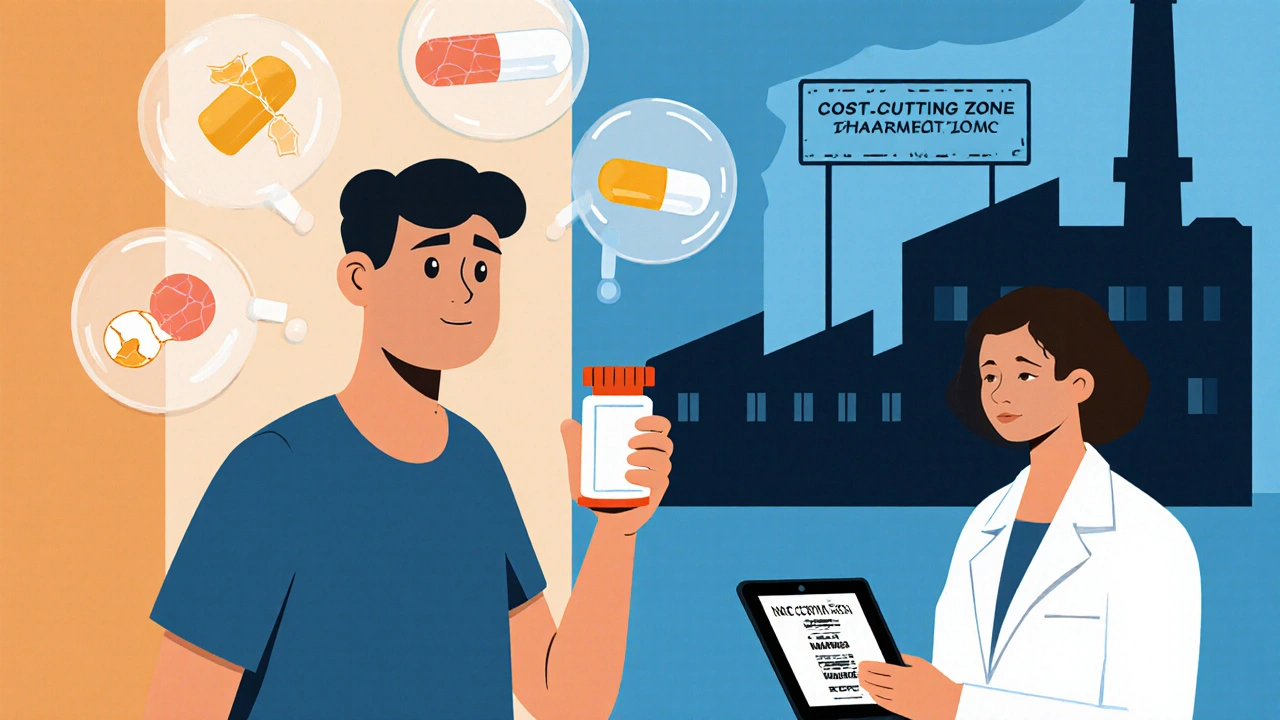Common Manufacturing Defects in Generic Medications and How They Impact Safety

When you pick up a generic pill at the pharmacy, you expect it to work just like the brand-name version. But behind that simple tablet is a complex manufacturing process where small mistakes can lead to big risks. Generic drug defects aren’t rare glitches-they’re systemic problems tied to cost-cutting, outdated equipment, and weak oversight. These aren’t just cosmetic issues. They can mean a pill doesn’t dissolve right, contains the wrong dose, or even carries harmful contaminants. For patients relying on these drugs daily, the consequences are real.
What Happens When a Generic Pill Goes Wrong?
Generic drugs are supposed to be identical to their brand-name counterparts in strength, safety, and effectiveness. But in practice, manufacturing flaws often make them anything but. The most common defects fall into four categories: physical damage, contamination, dosing errors, and labeling mistakes.Take capping, for example. That’s when the top of a tablet splits off cleanly during production. It happens when compression force is too high and the granules are too dry-common in hydrophobic drugs like certain blood pressure medications. A capping tablet won’t dissolve properly in the stomach, meaning the patient gets no medicine at all. In one 2023 batch of a generic metoprolol ER, 14% of tablets showed capping, leading to a full recall.
Lamination is similar but worse: layers peel apart inside the pill. This often occurs when tablet presses run too fast-above 40 rotations per minute-and pre-compression isn’t set right. The result? A pill that crumbles in your hand or dissolves too quickly, spiking blood levels of the active ingredient. One patient reported severe dizziness after switching to a generic version of levothyroxine that later tested as having inconsistent release profiles due to lamination.
Sticking happens when the drug material clings to the metal punch heads during compression. This is especially common with APIs that melt easily-like those with melting points below 120°C-when moisture levels rise above 4%. The machine keeps producing pills, but each one has a different weight. Some are too weak; others are dangerously strong. In one case, a batch of generic metformin had weight variations of up to 18%, far beyond the USP limit of ±5%.
And then there’s mottling-uneven coloring. It doesn’t affect potency, but it scares patients. Pharmacists report patients refusing pills that look “dirty” or “spotted,” even when they’re perfectly safe. But mottling often signals deeper mixing problems, meaning the active ingredient isn’t evenly distributed. That’s a red flag for dosing inconsistency.
Why Are Generic Drugs More Prone to These Problems?
Branded drugmakers spend 15-18% of their production budget on quality control. Generic manufacturers average just 8-10%. Why? Because they’re locked in a race to the bottom on price. A single pill might sell for pennies. Profit margins are razor-thin. So companies cut corners-on staff training, equipment upgrades, and lab testing.Many generic plants are decades old. Some were built in the 1970s and never upgraded. They use batch processing-making one batch at a time-which is slower and more error-prone than modern continuous manufacturing. In batch processing, a single mistake can ruin an entire batch of 500,000 pills. In continuous manufacturing, defects are caught and corrected in real time, reducing error rates by up to 65%.
Another problem: shared facilities. The same machine that makes a generic blood thinner might be used the next day to make a generic antibiotic. Cleaning protocols are often minimal. Cross-contamination isn’t rare. In 2022, the FDA found traces of a powerful blood pressure drug in a batch of generic antidepressants. No one got sick-but it was a close call.
And inspections? They’re not enough. In 2023, 57% of generic manufacturing facilities failed FDA inspections, compared to just 28% of branded ones. Many of those failures were for CGMP violations-Current Good Manufacturing Practices. These are the basic rules for keeping drugs safe. Skipping them isn’t an accident. It’s a business decision.

The Human Cost: What Patients and Pharmacists See
Behind every defective pill is a person who took it. Pharmacists are on the front lines. A 2023 survey of 1,247 U.S. pharmacists found that 68% had seen quality issues with generics in the past year. Nearly half reported patients complaining about pills that crumbled, cracked, or looked discolored. One pharmacist in Ohio described receiving a shipment of generic omeprazole where 20% of tablets were visibly chipped. Patients were vomiting after taking them. The pharmacist had to throw out the whole batch.Then there’s the silent problem: therapeutic inequivalence. A patient switches from a brand-name drug to a generic. They feel worse. Their blood pressure spikes. Their seizures return. They go back to the brand. But their insurance won’t cover it. So they stop taking it. That’s not speculation-it’s documented in hospital formulary data. In 2023, 9.8% of generic substitution requests were denied by doctors because of prior quality issues.
The FDA’s MedWatch system received 1,842 reports in 2023 directly linking adverse events to generic drug quality. Over 300 of those involved visible defects-chips, cracks, discoloration. But most reports never get filed. Patients assume the pill is fine. Doctors assume the generic is equivalent. The system doesn’t catch it until someone gets hurt.
How Manufacturers Are Trying to Fix This
Some companies are stepping up. The FDA’s Emerging Technology Program has helped 47 generic manufacturers switch to continuous manufacturing. At Sandoz and Dr. Reddy’s, AI-powered inspection systems now scan tablets at 600 per minute, spotting defects as small as 0.1 mm. That’s 92% accurate-far better than human inspectors, who miss about 30% of flaws.Modern plants now use real-time weight monitors that reject pills outside ±5% of target. They track compression forces down to the gram. They monitor humidity and temperature in the production room every 15 minutes. Staff get 40+ hours of GMP training every year. These aren’t luxuries-they’re necessities.
But only a fraction of manufacturers have made these investments. The rest still rely on manual checks, aging presses, and paper logs. The Generic Pharmaceutical Association estimates it would take $28.7 billion to bring all U.S. generic facilities up to modern standards. The industry spends $1.2 billion a year. The gap is widening.

What You Can Do
You can’t control what’s in the pill bottle. But you can be aware. If you switch to a generic and feel different-worse, not just different-talk to your pharmacist. Ask if there’s been a recent change in the manufacturer. Ask if the pill looks different. Take a photo. Report it.Pharmacists can check the National Drug Code (NDC) to see if the batch has been flagged. If you’re on a critical medication-like warfarin, levothyroxine, or seizure drugs-ask your doctor if you should stick with the brand. Insurance may push for generics, but your health matters more.
And if you see something wrong-a tablet that breaks apart, looks odd, or doesn’t work like before-file a report with the FDA’s MedWatch system. It takes five minutes. It might save someone else’s life.
What’s Next?
The FDA’s 2024-2027 plan aims to cut quality-related shortages by 30%. That means pushing for more advanced manufacturing, faster inspections, and real-time data sharing. But without more funding and stricter enforcement, progress will be slow.The market is growing-projected to hit $782 billion by 2030. More patients will rely on generics. But if quality doesn’t improve, more will suffer. The system isn’t broken. It’s being starved. And the cost isn’t just financial. It’s measured in missed doses, hospital visits, and lives lost.
Are generic drugs less effective than brand-name drugs?
Generic drugs are required by law to be bioequivalent to their brand-name counterparts. That means they should work the same way in your body. But manufacturing defects-like uneven dosing, poor dissolution, or contamination-can make them less effective. In 7.3% of generic applications between 2015 and 2020, bioequivalence failures were traced to manufacturing inconsistencies, not formulation differences. So while generics are designed to be the same, quality issues can make them different in practice.
What are the most dangerous types of generic drug defects?
The most dangerous defects are those that affect dosage accuracy. Weight variation over ±5%, contamination with foreign particles (especially in injectables), and incomplete dissolution due to capping or lamination can lead to underdosing or overdosing. For drugs with narrow therapeutic windows-like warfarin, lithium, or levothyroxine-even small changes in dose can cause serious harm, including strokes, seizures, or heart failure.
Can I tell if my generic pill has a manufacturing defect?
Yes, sometimes. Look for visible signs: chipping, cracking, unusual color spots, or pills that crumble when you touch them. If the pill looks different from your last refill-especially if it’s a different shape, size, or color-ask your pharmacist. They can check the manufacturer and lot number. If you notice a change in how you feel after switching generics, that’s also a red flag. Don’t assume it’s just your body adjusting.
Why do some generic brands seem better than others?
Because they are. Generic drug manufacturers vary widely in quality. Big companies like Teva and Sandoz have modern facilities and low batch rejection rates (under 1%). Smaller manufacturers often operate older plants with higher defect rates-sometimes over 3%. The same generic drug can come from different factories depending on supply. That’s why your pill might look different each time. Always ask your pharmacist which company made your prescription.
Should I avoid generic drugs altogether?
No. Most generics are safe and effective. But for critical medications-like thyroid drugs, seizure meds, or blood thinners-it’s worth asking if the brand version is necessary. If you’ve had problems with a generic before, don’t switch back without telling your doctor. And always report any quality issues to the FDA. Your feedback helps improve the system.

Amie Wilde
November 13, 2025 AT 10:33I switched to a generic metoprolol last month and felt like I was getting zombified. Went back to brand-same script, same dose, totally different. No idea why no one talks about this.
Gary Hattis
November 15, 2025 AT 09:27My cousin in India gets her generic levothyroxine from a factory that used to make pesticides. No joke. The FDA inspects US plants, but most generics are made overseas where oversight is a joke. We’re not just saving money-we’re gambling with lives.
Esperanza Decor
November 16, 2025 AT 20:01My pharmacist showed me a batch of generic omeprazole that looked like someone dropped a bag of marbles in a paint can. Some were speckled, some were cracked. She threw the whole box out. I didn’t even know you could see defects like that. Now I take pictures before I swallow anything.
Deepa Lakshminarasimhan
November 18, 2025 AT 18:16They’re doing this on purpose. The big pharma companies own the generics too. They want you to think it’s safe so you keep buying cheap pills while they make billions off the brand versions. The FDA? They’re paid off. Look at the revolving door between regulators and drug execs. This isn’t negligence-it’s a scheme.
Erica Cruz
November 19, 2025 AT 08:23Oh wow, another ‘concerned citizen’ piece about generics. Let me guess-this is the same person who thinks ‘natural’ means ‘safe’ and that ‘chemicals’ are evil? The bioequivalence standards are strict. If your pill doesn’t work, maybe it’s your metabolism, not the manufacturer. Stop blaming pills and start blaming your own body.
Johnson Abraham
November 20, 2025 AT 07:06lol why do people care if a pill looks weird? it’s still the same chem. i’ve taken generic cipro that looked like it was made in a garage and i didn’t die. also the brand name stuff is just rebranded generics anyway. stop being a drama queen.
Shante Ajadeen
November 21, 2025 AT 12:46Thank you for writing this. I’m a nurse and I’ve seen patients stop their meds because the pills looked different. They think they’re broken or poisoned. We need more education-not just for patients, but for doctors too. A simple ‘this batch is from a new maker’ note could save someone’s life.
dace yates
November 22, 2025 AT 23:06Has anyone looked into whether the colorants or fillers in generics cause reactions? I’ve had weird rashes with some generics but not others. Not sure if it’s the API or the excipients.
Danae Miley
November 24, 2025 AT 09:36Manufacturing defects in generics are not anecdotal-they’re statistically significant. The FDA’s own data shows that 57% of generic facilities fail CGMP inspections. That’s not a flaw in the system-it’s the system. And the fact that we accept this as normal is a moral failure.
Charles Lewis
November 25, 2025 AT 04:39While the concerns raised here are valid and well-documented, it’s essential to contextualize them within the broader landscape of pharmaceutical access. Generics account for over 90% of prescriptions filled in the U.S., and for millions of low-income and elderly patients, they are the only viable option. The real issue isn’t the existence of defective generics-it’s the lack of investment in quality control infrastructure, the consolidation of manufacturing into fewer, often overseas, facilities, and the failure of regulatory agencies to enforce standards with adequate resources. We must advocate for systemic reform-not fear or avoid generics, but demand better oversight, increased funding for inspections, and incentives for manufacturers to adopt modern continuous manufacturing technologies. This isn’t about trust in pills-it’s about trust in our public health institutions to protect us.